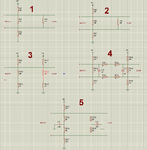seyyah
Advanced Member level 2
I have a master device in a machine room with two 7.5KW inverters and ac motors around. And a slave device 30 meters away from this room. Master and slave are on the same ground and communicates over RS485. Cable has parameters of C=3,3nF, L=60µH and Z= 135ohms. Cable is straight(flat cable) and unshielded and there is no way of changing it. Without inverters are running, communication is fine. But when inverters run, it malfunctions most of the time. I'm using standart SN75176 chips and transzorbs on both lines for protection. Used configurations are in the attachment and I also tried removing termination but not biasing on either sides. I've tried communication speeds of 2400bps to 19200 bps. The most reliable one was the 19200bps without any termination but with 470 ohm biasing and failed rarerly. Also slave side almost always gets the correct information but master side is the main side that is failing. I could not find a solution. May I take your suggestions please?Thanks
Attachments
Last edited:
